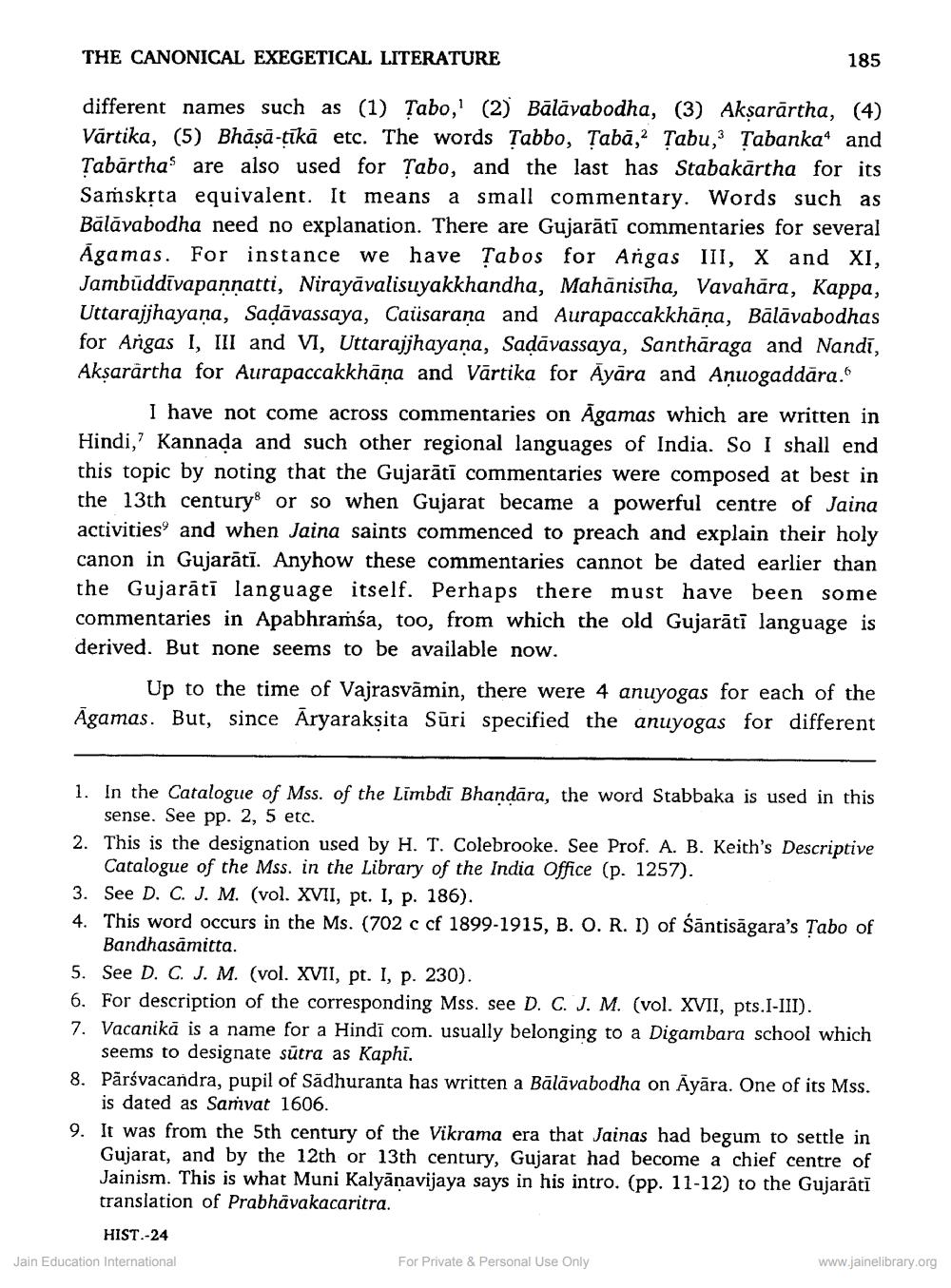________________
THE CANONICAL EXEGETICAL LITERATURE
185
different names such as (1) Tabo, (2) Bālāvabodha, (3) Aksarārtha, (4) Vārtika, (5) Bhasa-tīkā etc. The words Tabbo, Tabā,2 Tabu, Tabanka" and Tabarthas are also used for Tabo, and the last has Stabakārtha for its Samskrta equivalent. It means a small commentary. Words such as Balávabodha need no explanation. There are Gujarātī commentaries for several Āgamas. For instance we have Tabos for Argas III, X and XI, Jambūddīvapannatti, Nirayāvalisuyakkhandha, Mahānistha, Vavahāra, Kappa, Uttarajjhayana, Sadāvassaya, Caüsarana and Aurapaccakkhāna, Bālāvabodhas for Angas I, III and VI, Uttarajjhayana, Sadāvassaya, Santhāraga and Nandi, Aksarärtha for Aurapaccakkhāna and Vārtika for Āyāra and Anuogaddāra.
I have not come across commentaries on Agamas which are written in Hindi, Kannada and such other regional languages of India. So I shall end this topic by noting that the Gujarāti commentaries were composed at best in the 13th century or so when Gujarat became a powerful centre of Jaina activities and when Jaina saints commenced to preach and explain their holy canon in Gujarātī. Anyhow these commentaries cannot be dated earlier than the Gujarāti language itself. Perhaps there must have been some commentaries in Apabhramsa, too, from which the old Gujarātī language is derived. But none seems to be available now.
Up to the time of Vajrasvāmin, there were 4 anuyogas for each of the Agamas. But, since Āryarakṣita Sūri specified the anuyogas for different
1. In the Catalogue of Mss. of the Limbdī Bhandāra, the word Stabbaka is used in this
sense. See pp. 2, 5 etc. 2. This is the designation used by H. T. Colebrooke. See Prof. A. B. Keith's Descriptive
Catalogue of the Mss. in the Library of the India Office (p. 1257). 3. See D. C. J. M. (vol. XVII, pt. I, p. 186). 4. This word occurs in the Ms. (702 c cf 1899-1915, B. O. R. 1) of śāntisāgara's Tabo of
Bandhasamitta. 5. See D. C. J. M. (vol. XVII, pt. I, p. 230). 6. For description of the corresponding Mss. see D. C. J. M. (vol. XVII, pts.I-III). 7. Vacanikā is a name for a Hindi com. usually belonging to a Digambara school which
seems to designate sutra as Kaphi. 8. Pārsvacandra, pupil of Sädhuranta has written a Bālāvabodha on Ayāra. One of its Mss.
is dated as Samvat 1606. 9. It was from the 5th century of the Vikrama era that Jainas had begum to settle in
Gujarat, and by the 12th or 13th century, Gujarat had become a chief centre of Jainism. This is what Muni Kalyānavijaya says in his intro. (pp. 11-12) to the Gujarati translation of Prabhävakacaritra.
HIST.-24 Jain Education International
For Private & Personal Use Only
www.jainelibrary.org




